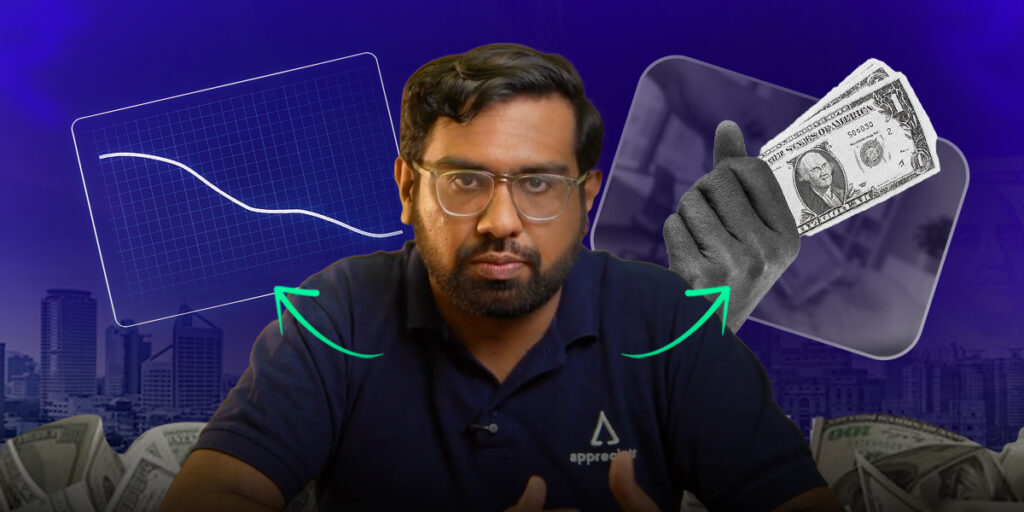With the price of gold breaching the ₹1,00,000 per 10 gm mark for the first time, investors are seeking new ways to ride this rally. Traditionally, gold has been a safe haven during market uncertainty, often moving in the opposite direction of stocks—when equities fall, demand for gold tends to rise.
But here’s where gold mining ETFs come in. These unique investment vehicles combine the stability of gold with the growth potential of equities. They offer investors a smart way to double down on gold’s momentum.
Through platforms like Appreciate, investors can easily gain access to these gold mining ETFs and other investment options that align with their financial goals. Appreciate makes it simple to diversify your portfolio and take advantage of the opportunities in the gold market. In this post, we’ll highlight three gold mining ETFs that are outpacing even the metal itself.
Gold vs Equity
When equity markets decline, gold tends to rise. During market turbulence, investors flee riskier assets like stocks and pour their capital into safe-haven assets like gold.
In 2025, global equity markets have faced challenges due to rising inflation, renewed tariffs between the U.S. and China, particularly under the leadership of former President Donald Trump, and central banks pausing interest rate hikes. These factors have led to a decline in stock prices and driven gold to reach record levels.
In this environment, gold mining ETFs present a compelling opportunity. They combine the surge in gold prices with the profit potential of mining companies, enhancing returns while still serving as a hedge against market volatility.
Why Not Physical Gold?
While physical gold remains a dependable store of value, it comes with limitations—storage, insurance, and zero yield. Gold ETFs, on the other hand, offer ease of access, liquidity, and no need for safes or vaults. Both physical gold and gold ETFs fall under the broader category of what are alternative investments, which includes assets beyond traditional stocks and bonds. They also allow for fractional ownership, meaning investors can start with a smaller budget.
Beyond convenience, gold ETFs trade like stocks, enabling intraday buying and selling. This flexibility is crucial in fast-moving markets. When the goal is exposure to gold price movements without the hassle of physical ownership, ETFs win.
Gold ETFs vs Gold Mining ETFs
So, what’s the difference between traditional gold ETFs and gold mining ETFs?
Gold ETFs such as SPDR Gold Shares (GLD) benchmark the price of physical gold, providing a straightforward way to invest in the metal without the risks tied to individual companies.
Gold mining ETFs, however, invest in companies that produce gold. This means they’re equities with exposure to gold. The big benefit? Leverage. When gold prices rise, miners often see their profits multiply, leading to higher stock returns than gold itself.
But that comes with added risk. Mining operations face costs, regulatory hurdles, and geopolitical tensions. Still, in a bull market for gold, the upside potential of mining ETFs can significantly outpace the metal.
These mining ETFs present a high-octane alternative for investors who want to ride the wave harder.
1. Sprott Gold Miners ETF (SGDM)
- YTD Return: 42.65%
- Expense Ratio: 0.50%
- Index Tracked: Solactive Gold Miners Custom Factors Index
SGDM focuses on larger, senior gold producers primarily based in North America. What sets it apart is its unique weighting strategy. Rather than simply tracking market cap, SGDM adjusts weights based on revenue growth, long-term debt levels, and price momentum.
That means you’re not just investing in the biggest names, but those with solid financials and strong performance signals. This smart-beta strategy has helped SGDM shine in bullish gold environments.
If you want a concentrated play on established miners with a performance tilt, SGDM is a top-tier option.
2. iShares MSCI Global Gold Miners ETF (RING)
- YTD Return: 39.08%
- Expense Ratio: 0.39%
- Index Tracked: MSCI ACWI Select Gold Miners IMI
RING casts a wider net. It includes global gold miners across developed and emerging markets. You’re getting exposure to companies in the U.S., Canada, Australia, South Africa, and more.
This geographical diversification can help buffer against country-specific risks while tapping into gold’s worldwide demand. RING is also among the most cost-efficient ETFs in this space, with a low expense ratio.
If you’re looking for a globally balanced approach with strong performance, RING deserves a spot on your watchlist.
3. VanEck Gold Miners ETF (GDX)
- YTD Return: 37.89%
- Expense Ratio: 0.51%
- Index Tracked: NYSE Arca Gold Miners Index (GDM)
GDX is the most widely recognized and traded gold mining ETF globally. It holds a basket of top-tier gold and silver mining companies, offering high liquidity and broad market coverage.
This ETF is a go-to for institutional and retail investors alike. It provides an easy, scalable way to invest in the sector without hand-picking individual stocks. GDX also benefits from being highly liquid, which means tighter bid-ask spreads and better execution for traders.
If you want broad exposure with trading efficiency, GDX is a cornerstone ETF.
The returns mentioned above are as of April 23, 2025.
Final Thoughts
Gold mining ETFs offer a strong opportunity to benefit from rising gold prices while also gaining from the growth of mining companies.
In 2025, with ongoing inflation concerns and economic uncertainty, gold prices are expected to continue rising. ETFs like SGDM, RING, and GDX allow investors to take advantage of this trend, offering higher returns, potential dividends, and diversification.
Through platforms like Appreciate Wealth, investors can easily access these ETFs and other investment options, helping them maximize profits while still benefiting from the stability of gold. For those seeking to enhance their portfolios, these ETFs are an excellent choice.
For those seeking to maximize profits while still gaining the stability of gold, these ETFs are an excellent choice.
Disclaimer: Investments in securities markets are subject to market risks. Read all the related documents carefully before investing. The securities quoted are exemplary and are not recommendatory.























